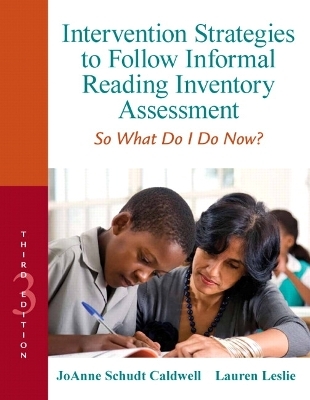
Intervention Strategies to Follow Informal Reading Inventory Assessment
Pearson (Verlag)
978-0-13-290708-8 (ISBN)
- Titel z.Zt. nicht lieferbar
- Versandkostenfrei innerhalb Deutschlands
- Auch auf Rechnung
- Verfügbarkeit in der Filiale vor Ort prüfen
- Artikel merken
Today teachers need valid research-based measures for reading improvement, assessments to determine students' reading abilities, and intervention strategies to guide students back on track. To help teachers connect students' performance and evaluation to instruction, best-selling authors JoAnne Caldwell and Lauren Leslie outline practical intervention strategies that are aligned with any informal reading inventory. Targeting the latest research, this edition includes new student case studies, more writing applications, a focus on teaching with classroom materials, and a new PDToolkit (available either with the book or alone). By identifying intervention strategies based on assessment, the book helps teachers and students address difficulties in word identification, fluency, prior knowledge, and comprehension.
JoAnne Schudt Caldwell is the co-author/author of seven titles including The Qualitative Reading Inventory-5 and Reading Problems: Assessment and Teaching Strategies both published by Allyn & Bacon. She received her Ph.D. in Educational Psychology from Marquette University and is Professor Emerita at Cardinal Stritch University. In 1996 she received the Outstanding Service Award from the Wisconsin State Reading Association, as well as the Wisconsin Teacher Educator of the Year Award in 1997 and the Achievement Award from Marquette University School of Education in 2005. Lauren Leslie received her Ph.D. in Educational Psychology from the University of Iowa and is currently Emeritus Professor at Marquette University where she served as the director of the Hartman Literacy Center for many years. She has published over 25 research articles, and she is the co-author of the Qualitative Reading Inventory-5. She received the Albert J. Harris Award from International Reading Association (2001) for article written with L. Allen, “Factors that predict success in an early literacy intervention program.” She also received the Mary Neville Bielefeld Award for Career Achievement for her contributions to teaching, research and service, particularly the mentoring of women faculty and students.
Chapter One: An Overview of Reading Instruction for Struggling Readers
Reading Instruction–Past and Present Perspectives
Successful Intervention — A New Perspective
Principles of Effective Intervention Programs
Current Issues
Summary
References and Recommended Readings
Chapter Two: Patterns of Reading Difficulty
General Patterns
Defining a Student’s Reading Level
Reading Level: An Indicator of Problem Severity
Reading Level: An Indicator of Word Identification Proficiency
Reading Level: An Indicator of Comprehension Proficiency
Designing the Intervention Focus
Summary
References and Recommended Readings
Chapter Three: The Structure of Intervention Sessions
The Importance of Consistent Structure
Individual Intervention Structures K-5
Group Intervention Structures K-5
Intervention Structures 6-12
Classroom Intervention Structures That Foster the Growth of Struggling Readers
Designing Your Own Structure
Application to English Language Learners
Application to Adolescent Learners
Response to Intervention
Summary
References and Recommended Readings
Chapter Four: Phonological Awareness
What Is Phonological Awareness and Why Is It Important?
The Importance of Rhyme
The Informal Reading Inventory as an Indicator of Rhyme Knowledge
Phonological Awareness Instruction
The Importance of Phonemic Awareness
Developing Phonemic Awareness Aurally
Application to Writing
Application to English Language Learners
Application to Adolescent Learners
Response to Intervention
Summary
References and Recommended Readings
Chapter Five: Word Identification Instruction: Phonics and More
What Is Systematic Phonics Instruction?
The Informal Reading Inventory as an Indicator of Problems with Word Identification
Guidelines for Exemplary Phonics Instruction
Teaching Consonant Sounds Using Shared Reading
Procedures for Teaching Consonant Sounds Using Shared Reading
Teaching Vowel Sounds: Using Spelling Patterns to Read by Analogy
The Importance of Cross-Checking
How to Learn Words That Are Difficult to Decode
Putting It All Together: Guided Reading
Teacher Prompting during Oral Reading
Application to Spelling
Application to English Language Learners
Application to Adolescent Learners
Response to Intervention
Summary
References and Recommended Readings
Chapter Six: Word Identification Instruction: Fluency
The Importance of Fluency
The Informal Reading Inventory as an Indicator of Lack of Fluency
General Principles for Developing Fluency
Instructional Activities for Developing Fluency
Application to English Language Learners
Application to Adolescent Learners
Response to Intervention
Summary
References and Recommended Readings
Chapter Seven: Prior Knowledge and Concept Development
How Prior Knowledge Affects Comprehension
How to Assess Prior Knowledge
Building a Knowledge Base: Concept Development
Application to English Language Learners
Application to Adolescent Learners
Response to Intervention
Summary
References and Recommended Readings
Chapter Eight: Vocabulary Learning
The Importance of Vocabulary Learning
The Informal Reading Inventory as an Indicator of Vocabulary Learning
General Principles for Developing Vocabulary Learning
Instructional Activities for Fostering Word Learning
Application to Writing
Application to English Language Learners
Application to Adolescent Learners
Response to Intervention
Summary
References and Recommended Readings
Appendix
Chapter Nine: Comprehension Instruction: Retelling Narrative Text
The Importance of Retelling
What is an Effective Retelling?
How is an Understanding of Narrative Structure Developed?
The Informal Inventory as an Indicator of Ability to Retell Narrative Text
General Principles for Developing Narrative Retelling
Biographies: Bridging Narrative and Expository Text
Application to English Language Learners
Application to Writing
Application to Adolescent Learners
Response to Intervention
Summary
References and Recommended Readings
Chapter Ten: Comprehension Instruction: Expository Retelling
Retelling Expository Text
The Informal Reading Inventory as an Indicator of Ability to Retell Expository Text
General Principles for Developing Effective Expository Retellings
Instructional Strategies for Constructing Expository Retellings
Expository Idea Map
Main Idea Map
Application to Writing
Application to English Language Learners
Application to Adolescent Learners
Response to Intervention
Summary
References and Recommended Readings
Appendix
Chapter Eleven: Comprehension Instruction: Answering Questions
The Complexity of Answering Questions
The Importance of Self-Questioning
The Informal Reading Inventory as an Indicator of Ability to Answer Questions
General Principles for Helping Students to Answer Questions
Instructional Activities for Answering Questions
Application to Writing
Application to English Language Learners Application to Adolescent Learners 206
Response to Intervention
Summary
References and Recommended Readings
Chapter Twelve: Comprehension Instruction: General Interactive Strategies
The Importance of Comprehension Strategies
The Informal Reading Inventory as an Indicator of Problems with Comprehension
Frameworks for Interactive Teaching of Comprehension Strategies
Application to Writing
Application to English Language Learners
Application to Adolescent Learners
Response to Intervention
Summary
References and Recommended Readings
Chapter Thirteen: Pulling It All Together: Designing the Intervention Structure
Primary Level
Intermediate Level
Middle Level
Generic Intervention Plan
Summary
Appendix Summary of Intervention Strategies
Index
| Erscheint lt. Verlag | 14.11.2012 |
|---|---|
| Sprache | englisch |
| Maße | 218 x 277 mm |
| Gewicht | 746 g |
| Themenwelt | Schulbuch / Wörterbuch |
| Sozialwissenschaften ► Pädagogik ► Berufspädagogik | |
| Sozialwissenschaften ► Pädagogik ► Schulpädagogik / Grundschule | |
| ISBN-10 | 0-13-290708-9 / 0132907089 |
| ISBN-13 | 978-0-13-290708-8 / 9780132907088 |
| Zustand | Neuware |
| Informationen gemäß Produktsicherheitsverordnung (GPSR) | |
| Haben Sie eine Frage zum Produkt? |
aus dem Bereich


